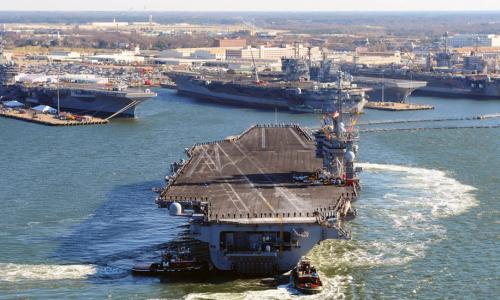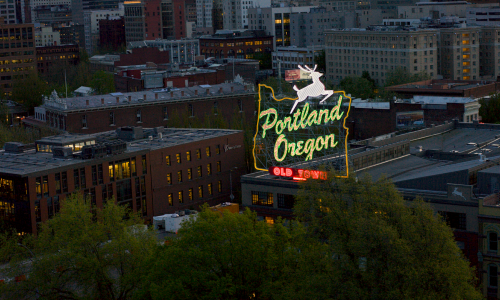Seas are projected to rise between 4 and 6.4 feet by the end of this century in the area around Washington, DC.
During the second half of the century, in the absence of preventive measures, Joint Base Anacostia-Bolling and Washington Navy Yard can expect more frequent and extensive tidal flooding, loss of currently utilized land, and substantial increases in the extent and severity of storm-driven flooding. With an intermediate rate of sea level rise, NSF Anacostia could lose roughly 50 percent of its land area by end of century.
Base information
This location is one of 18 military installations featured in the 2016 report, "The US Military on the Front Lines of Rising Seas."
Joint Base Anacostia-Bolling (JBAB) is located in the southeastern portion of Washington, DC, along the Potomac and Anacostia rivers. Liket the Washington Navy Yard, it is situated within an East Coast hot spot of rising seas, where natural subsidence, low-lying topography, and changing ocean circulation patterns contribute to above-average sea level rise.
JBAB comprises NSF Anacostia and Bolling AFB. The major tenant command on JBAB is the Defense Intelligence Agency, the DoD combat support agency that provides military intelligence information to combat and noncombat military missions. The US Naval Research Laboratory and the White House Communications Agency are also located at JBAB. Bolling AFB provides administrative support to the air force and is the home of the 11th Wing, “The Chief’s Own.”
Washington Navy Yard is the oldest US Navy shore facility. Originally a shipbuilding facility, the installation now provides administrative and ceremonial functions.
The yard is also home to the Commander, Navy Infrastructure Command (CNIC), which manages coastal installations for the US Navy, and several other tenant commands, including the Naval Facilities Engineering Command and the Naval Inspector General. While the workforce does include Navy and Marine Corps personnel, the majority of employees are civilians, including Navy contractors, engineers, lawyers, and procurement officials.
Projected exposure to coastal flooding
The bases' exposure to coastal flooding is projected for the years 2050, 2070, and 2100 based on the National Climate Assessment’s midrange or “intermediate-high” sea level rise scenario (referred to here as “intermediate”) and a “highest” scenario based on a more rapid rate of increase.
Tidal flooding, land loss, and storm surge from hurricanes were all modeled. In this analysis, land inundated by at least one high tide each day is considered a loss. This is a conservative metric: in reality, far less frequent flooding would likely lead to land being considered unusable.
The results below outline potential future flooding scenarios for these installations, assuming no new measures are taken to prevent or reduce flooding.
- Areas currently unaffected by occasional tidal flooding could flood more often than daily. Naval Support Facility (NSF) Anacostia, the northern half of JBAB, is currently affected by flooding during extra-high tides more than 40 times per year on average. By 2050, floodprone areas could experience 450 to 600 floods per year, depending on the scenario.
- Flooding during extreme high tides will become more extensive. Extreme high tides do not typically flood the Washington Navy Yard today. But in the highest scenario, roughly 40 percent of Washington Navy Yard is inundated by the end of this century during the extra-high tides that affect the area more than 40 times per year on average.
- Extensive land loss at NSF Anacostia is possible. In the intermediate scenario, which projects four feet of sea level rise by the end of the century, roughly 50 percent of NSF Anacostia’s land area—primarily developed, utilized land—floods daily, effectively becoming part of the tidal zone.
- Sea level rise exposes previously unaffected areas of JBAB and Washington Navy Yard to storm surge flooding. In the intermediate scenario, the area of Washington Navy Yard exposed to flooding increases by 25 percent or more during Category 1 and 2 storms by 2100.
- Sea level rise exposes JBAB and Washington Navy Yard to deeper, more severe flooding. Over time, the area inundated during storm surges by seawater five feet or more deep increases.
Preparing for rising seas
The gap between the military’s current preparedness for sea level rise and the threats outlined here is large and growing.
In order to plan effectively for the long term, military decision makers with authority over JBAB and Washington Navy Yard need to understand how sea level rise may permanently alter the landscape of these coastal installations and where the threat of storm surge may become intolerable.
To take action, however, installations like JBAB and Washington Navy Yard will need more detailed analysis and resources to implement solutions.
Congress and the Department of Defense should, for example, support the development and distribution of high-resolution hurricane and coastal flooding models; adequately fund data monitoring systems such as our nation’s tide gauge network; allocate human, financial, and data resources to detailed mapping and planning efforts at military installations; and, as adaptive measures are identified, allocate resources for these projects, many of which will stretch over decades.
Our defense leadership has a special responsibility to protect the sites that hundreds of thousands of Americans depend on for their livelihoods and millions depend on for national security.
Additional maps and resources
This analysis modeled exposure to coastal flooding for four different points in time (2012, 2050, 2070, and 2100) and two different sea level rise scenarios.
For each time horizon and scenario, we analyzed storm surge from Category 1 through 5 hurricanes, the extent and frequency of flooding from extra-high tides, and inundation from ordinary high tides.
Detailed maps for each scenario at JBAB and Washington Navy Yard are available via Dropbox.
For more, please see the methodology used for this analysis.




